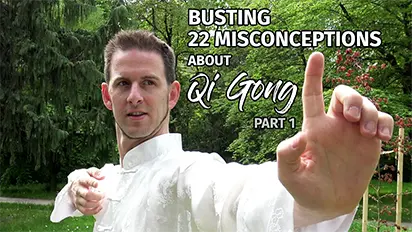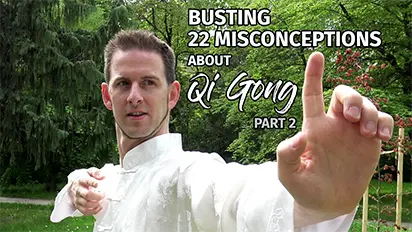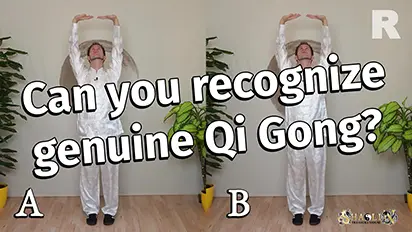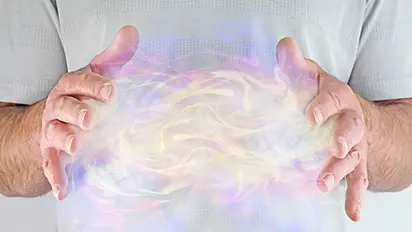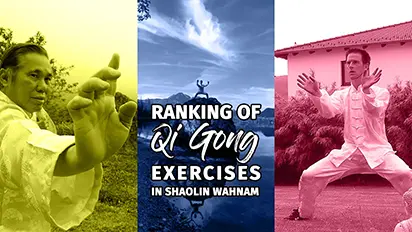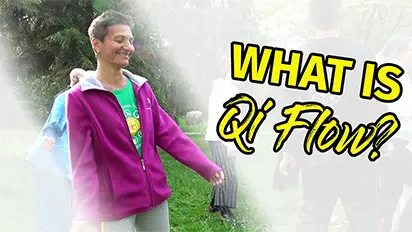Busting 22 Misconceptions About Qi Gong - Part 3/3

Qi Gong is dangerous
Interestingly, many people in Asia are actually hesitant to learn Qi Gong. The reason for this is the scary Chinese term for negative effects of incorrect practice, "Fire escapes, Evil enters" (Zou Huo Ru Mo).
However, this term is not to be taken literally, but simply means "negative side effects". To avoid these, it's important to find a good teacher and follow their instructions.
In general, Qi Gong is a very safe practice. In Shaolin Wahnam, we also have our safety valve, the “Qi Flow”, which immediately eliminates any unwanted effects, if they even arise.
So, don’t be shied away from possible dangers of Qi Gong. If you practice with the support of a good teacher in-person or by following a systematic online program and they will help you avoid and – if necessary – overcome deviations.
Keep the mouth closed and breathe out through the nose
It is a widespread practice among many practitioners to exhale through the nose, but this actually deprives them of a crucial effect. The mouth is far better suited to get rid of bad energy and toxins.
When we clear away blockages, which is the ultimate aim of Qi Gong, it may also result in yawning, sometimes long and loudly. This is a good indicator that for effective practice and at the same time a proof how important it is to keep the mouth open during practice.
Exhaling through the nose slows down the breath and, consequently, the pace of the practice, but as mentioned in the previous point, slow motion is not necessarily the ideal tempo.
In martial arts, if exhaling is done only through the nose and the mouth is always kept closed, it can lead to very negative effects in the long run.
The mouth expresses a variety of emotions. For example, we use it to laugh, cry, yell, and scream. Keeping the mouth closed prevents emotions from flowing freely and being released.
Qi Gong is always performed in slow motion.
In most Qi Gong presentations and schools, techniques are performed very slowly. This is not necessarily wrong, but it’s generally recommended to maintain a comfortable, moderate pace, as this stimulates the flow of energy better.
Especially exercises designed to generate a powerful “Qi Flow”, such as the “18 Jewels” and "5 Animal Play", are performed vigorously.
Exercises such as "Punching with wide Eyes" or some of the “18 Lohan Arts” are relaxed but also executed powerfully and fast. These techniques also debunk another prejudice, namely that Qi Gong is always quiet, as they are accompanied by powerful shouting or other sounds.
As mentioned before, Shaolin Kung Fu and Tai Chi Chuan are also forms of energy work, or Qi Gong. Especially Tai Chi is usually practiced like a slow-motion solo dance. However, as we practice it as a martial art, as originally developed, we have to execute the techniques far faster than most practitioners in order to use them effectively and in a timely manner.

While Qi Gong is often stationary and quiescent, some exercise are perform vigorously. The deer of the "5 Animal Play" even requires running around (which is a lot of fun).
Drawing energy from the ground
Directly taking in earth energy is not suitable for us humans. We live on cosmic energy and breathe it in with every breath.
We also depend on “earth energy” in the form of "grain energy", which corresponds to “food energy”, as the second important component in our energy supply but when we eat food, its energy is then transformed to vital energy during the process of digestion.
By the way, the reason why we should always wear shoes during practice is to prevent earth energy from seeping in while we are practicing and therefore open all “gates”.
I know that this topic is controversial, but rest assured that the past masters who developed this art always wore shoes and advised their students to do so too.
To meditate, you have to sit
Just by the fact that Qi Gong is a form of moving meditation, this misconception is already disproven.
But not only Qi Gong is meditation in motion. Cycling, dancing or washing dishes can also become a meditative practice. What is essential is not the external form, but the focused state of mind.
Therefore, the first skill we learn is to enter the "Qi Gong State of Mind". This improves the results in everything we do, especially in our practice.
Not thinking about anything is Zen.
Once you know this, walking, sitting, or lying down, everything you do is Zen.”
- Bodhidharma
There are many types and external forms of meditation.
Our “Qi Flow” is often referred to as "flowing meditation".
At the end of each practice session, we stand quietly in a “Standing Meditation”.
Sitting meditation constitutes the highest form of meditation and is the primary tool for those who cultivate for Enlightenment.
But most people just want to live a healthy and happy life. For those who don’t intend to become a monk or nun, Qi Gong provides them a much easier, safer as well as more convenient and effective approach to reach their goals.

The "Standing Meditation" at the end of our session is an important part of our practice.
The "Small Universe" (Micro-Cosmic Orbit) is a fundamental skill.
Some teachers believe that the first thing to do is to break through the “Small Universe” along the Ren and Du meridians. Only then can one practice effectively.
However, the "Small Universe" is one of the most advanced and highest arts of all.
Not only are the chances very low for beginners to attain this ability, the approach is inefficient and not entirely safe.
In our school, we continually witness the refutation of this assumption. Many of our students have achieved incredible results, which from the perspective of Western medicine, can only be described as miracles. They only had to learn relatively basic Qi Gong skills, such as generating “Qi Flow” or the “18 Jewels”, in a basic course.
The "Small Universe" should be reserved for advanced practitioners who have already cleared the grossest blockages and accumulated enough energy to allow the energy to overflow in the two meridians.
Qi Gong requires a lot of time
That brings us to another misconception. Qi Gong and other meditation practices are considered time-consuming, which is probably due to the large number of inefficient styles available. However, the daily effort required for authentic, high-quality Qi Gong is very low.
Anyone willing to do something good for themselves will have to admit that 10-15 minutes a day is always possible, no matter how busy they think they are.
So, if your teacher advises you to train for 1-2 hours a day, and especially if you feel little effect from it, you should question whether the style is worth the time and effort you need to spend.
What is true, of course, is that the path to mastery is long, but along the way, you will be rewarded with wonderful experiences and successes.
You'd like to know our special Shaolin Cosmos Qi Gong?
Then use this Online Mini Course to get
Although the course only scratches the surface, I’m always surprised by how enthusiastic many participants already are.
- Thank you very much for the great course… since I started practising the exercise, I feel much more relaxed.
- Feels amazingly good. Thank you so much. 🙏😊
- I really enjoyed it. It was informative and to the point. The exercise was explained very clearly and well structured. A beautiful exercise, presented in a very likeable way.
- This is incredibly soothing!
- Thank you for this wonderful exercise. Before practising I felt tired and low on energy, but now I clearly feel more energised and lighter.
- Very informative and easy to do — a great exercise that I will definitely keep using.
- Brilliant!
In my complete and in-depth course programs, I then teach the inner skills that will truly bring your practice to life.
Once students have learned those, their testimonials sound more like this:
This was the best Qigong course I have ever attended. Everything was perfect — the relaxed atmosphere, the detailed and well-founded explanations, and the presentation of the underlying philosophy that left no questions unanswered. You couldn’t design an online course any better.
- Klaus Micke
This course is exactly what I’ve been looking for for years! Finally, I can enjoy the Qi Flow instead of just experiencing gentle stretching and strengthening in a social setting at a sports club!
- Julia Holz
I enjoyed every practice session — and I still do. After each session, I feel refreshed and start the day with more energy than before. I’m still pleasantly surprised by what’s possible with just 15 minutes a day.
- Cora Hemken
Start now with the...
Related Topics:
Busting 22 Misconceptions About Qi Gong - Part 1/3
This series is all about dispelling common myths and misunderstandings about Qi Gong that leads to many people having a wrong conception of this powerful art.
April 23, 2023
Busting 22 Misconceptions About Qi Gong - Part 2/3
The series continues to bust common myths and misunderstandings about Qi Gong that leads to many people having a wrong conception of this powerful art.
June 17, 2023
Can you recognize genuine Qi Gong?
Qi Gong Riddle. Do you recognize the difference between authentic Qi Gong and gentle gymnastics?
January 7, 2023
What does Qi feel like?
Although many people doubt its existence, practitioners of authentic Qi Gong report manifold effects and sensations of this vital energy. Have a look at this selection.
January 8, 2024
Ranking of Qi Gong Exercises in Shaolin Wahnam
There are many Qi Gong arts and skills in our school, whose benefits range from health to enhancing performance and spiritual cultivation.
August 1, 2023
What is Qi Flow?
Read about a precious Qi Gong skill that is quite unknown but so effective in clearing any blockages. Find out more about Shaolin Wahnam's hallmark.
January 19, 2024
Breadth & Depth in Learning (Qi Gong)
When learning Qi Gong, Kung Fu or any other art, you can progress in two dimensions. You can add quantity by learning more and depth by increasing your skills.
October 25, 2023
Categories
Shaolin Qi Gong
Shaolin Kung Fu
Martial Arts
Benefits
Learning
Customs & Moral Code
Sneak Peak
VLOG Video
History
Follow Us
Author

Sifu Leo
Shaolin Wahnam Instructor
Hey there!
I’m Sifu Leo, Kung Fu enthusiast, father, drummer and computer geek from Austria. And, as many say, a kind and patient person and teacher.
I'm happy to share the knowledge and methods taught to me by the outstanding Shaolin Grandmaster, Wong Kiew Kit, with you.


